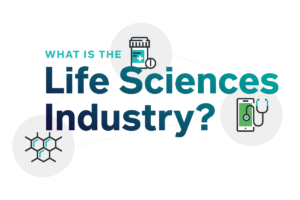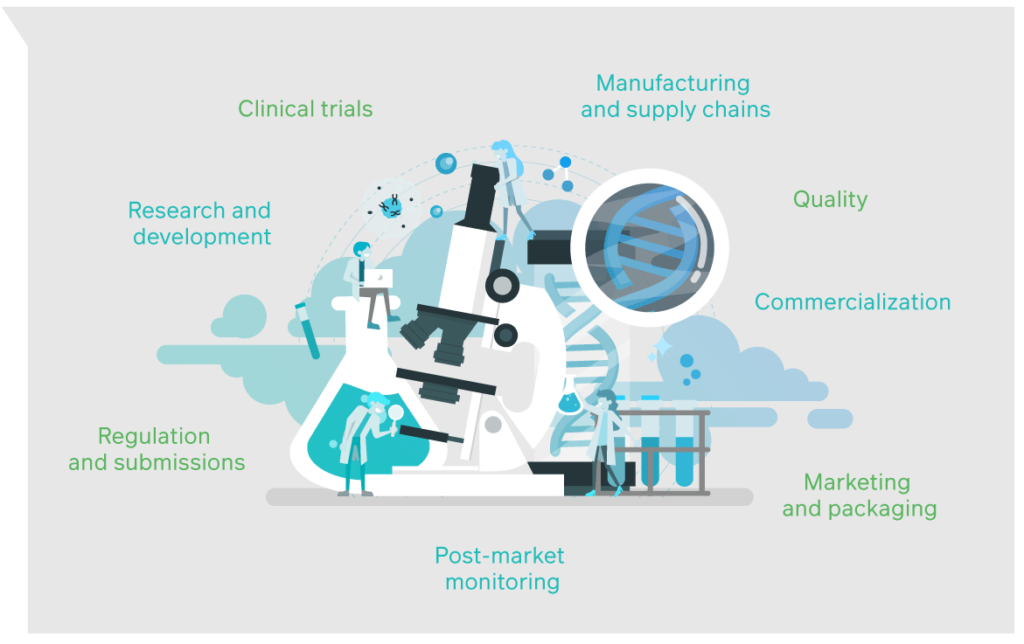
Given the inherently siloed nature of organizations in the life sciences industry, achieving a single view of the patient has been a key challenge for the life sciences sector. Yet, as patient centricity has become centrally important to all life science organizations, the industry has made more rapid efforts to include digitization in their operating models. How so? Read on for our insights!
Which digital opportunities should life science companies embrace in 2021? We have the scoop here!
What is the Life Sciences Industry?
Today, life sciences encompasses hard scientific development with physical products, including pharmaceuticals, therapeutics, diagnostics, medical devices, and other products and services that are designed to treat or aid in the treatment of customers and patients. And with COVID-19 in full swing, that has never been a greater need for the industry.
The life science industry’s main focus is to administer patient-centric care through better integrated data and insight that leads to better, healthier lives. In that same token, it must maintain a collaborative approach with the four P’s: patients, providers, payers, and partners. According to Investopedia, main focus areas of the industry include:
a. Pharma – Pharmaceutical companies create medicines from chemicals and synthetic processes. Pharmaceutical products can take many years to process through the research and development phases before finally making it to market. Part of the lengthy R&D process includes gaining the approval of the Food and Drug Administration (FDA). The largest companies in this sector provide stable results, but the field continues to grow with new companies opening regularly.
b. Biotech – Biotechnology (biotech) companies derive their products from the extraction or manipulation of living organisms. These companies research, develop, and produce a wide variety of commercial products, though most of them focus on medical or agricultural applications. Companies in this sector have developed pest-resistant crops, created biofuels like ethanol, and developed gene cloning. According to some projections, by 2026, medical biotechnology alone will hit $500 billion.
c. MDD (Medical Devices + Diagnostics) – this section is comprised of the medical products industry professionals develop, design, and manufacture that comply with complex and demanding regulations and market requirements.
Digital Transformation in Life Sciences
To create value-based, personalized medicines and maintain the focus on the patient, organizations have begun to implement transformative technologies like AI, analytics, IoT, blockchain, and cloud platforms. According to Bio IT World, there are eight ways emerging technologies will shape each stage of the drug lifecycle:

1. Research and development
From 2020 and beyond, R&D organizations will drive better patient outcomes by adopting interoperable data platforms that enable efficient collecting, synthesizing, analyzing, and communicating of information, moving from volume- to value-based research.
2. Clinical trials
AI-driven analytics is honing patient recruitment by scanning patient records to identify the most suitable candidates for trials, boosting retention and adherence in the process. Further, AI technologies allied to IoT platforms are supporting virtual trials, providing patient convenience and the ability to remote monitor, which will help reduce the number of people quitting trials.
3. Manufacturing and supply chains
As industry leaders move toward personalized medicines, pharmaceutical manufacturers will increasingly rely on AI, IoT and blockchain within the supply chain to add visibility and transparency with full product traceability—including monitoring the condition of sensitive drugs in transit.
4. Quality
Many life sciences companies have begun to increase the resolution of the data they collect using IoT and analytics. When it comes to Quality 4.0, companies will likely adopt an interoperable data platform across production and supply chain processes to enable new levels of cooperation and trust among all parties working along the life sciences value chain.
5. Commercialization
Both patients and physicians are becoming more empowered in this new era. As the physician gains access to the right support and information to improve diagnosis and drug discovery/prescription, the interoperable data platform once again will form the basis that enables secure data flows.
6. Marketing and packaging
As the impact of personalized medicine grows and patient-centricity increases, global pharmaceutical companies will be faced with developing many thousands of separate digital marketing assets that must meet regulatory requirements and be delivered at the right point in the patient journey. Organizations will meet the compliance, cost and complexity challenges of global marketing and packaging requirements by implementing enterprise marketing communications management platforms.
7. Regulation and submissions
To address drug monopolies, the FDA has the stated aim of cutting submission and approval times. To achieve this goal, regulators expect a much greater level of collaboration with all parties involved.
8. Post-market monitoring
The use of connected health wearables like Fitbits continues to increase. At the same time, patients are more willing to share their data with physicians and other trusted parties. Further, people are also beginning to select health care providers based on whether they offer telemedical and remote monitoring devices. While physician-supplied medical devices like pacemakers are FDA-regulated, many personal IoT-enables devices are not. To minimize potential security issues and data privacy risks, organizations will look towards identity-driven IoT platforms to gain the value of real time data from connected health wearables.
Stefanini’s Approach to Life Sciences
We use the latest digital technologies to transform Life Science business models. The TRUST Platform, formed in partnership with CliniOps, supports Digital Clinical Trials with Decentralized / Virtual Trial capabilities.
The TRUST Platform helps Pharma and Biotech companies to transform the clinical trial workflow by streamlining clinical data management, clinical operations and regulatory submission processes. TRUST is powered by Sophie AI, which supports integration with any internal or external sources like ClinicalTrials.Gov, Pubmed, Clinical Queries and other custom public data sources. Sophie also answers queries, questions, and retrieves documents. Finally, it automates and works as Help Desk support and a virtual assistant to users.
Are you interested in learning more about the various ways the TRUST platform can help your company on the path to digitally maturing? Chat with an expert today!



















